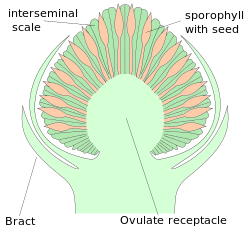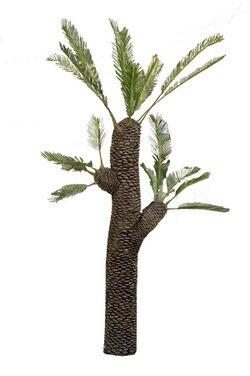Biology:Williamsonia (plant)
| Williamsonia | |
|---|---|

| |
| Cross section of Williamsonia harrisiana (India, Jurassic - Early Cretaceous) | |
| Scientific classification | |
| Kingdom: | Plantae |
| Clade: | Tracheophytes |
| Order: | †Bennettitales |
| Family: | †Williamsoniaceae |
| Genus: | †Williamsonia Carruth., 1870[1] |
| Type species | |
| Williamsonia gigas Carruth., 1870[1]
| |
Williamsonia is a genus of plant belonging to Bennettitales, an extinct order of seed plants. Within the form classification system used in paleobotany, Williamsonia is used to refer to female seed cones, which are associated with plants that also bore the male flower-like reproductive structure Weltrichia.[2]
Description
The monosporangiate[2] female Williamsonia seed cone (sometimes described as a "flower" though this does not imply homology with angiosperm flowers[3]) consists of an ovulate receptacle enclosed by bracts (modified leaves), with the receptacle bearing sporophylls with terminal seeds/ovules, which are surrounded by interseminal scales.[4] The micropyle of the ovules varied from protruding above the cone to slightly sunken in, depending on the species.[2] The cones were of variable shape, with reported morphologies including pyriform (pear shaped), ovoid, subspheroidal, and oblate spheroid[2] and could be up to 15 centimetres (5.9 in) in diameter. As many as 25–50 ovules could be present in each cone.[5] The cone was borne on a peduncle, and grew at the apex of a branch.[6][2] In at least some species, only one Williamsonia cone grew per active branch at any one time/season, while the cones from the preceding season/time developed into mature seed cones.[6] The cones have been suggested to be wind pollinated.[7] In at least some species, the cones increased in size during maturation, which might reflect the transformation of the interseminal scales into a fleshy coating possibly used to attract seed dispersers.[6]
Associated plant parts

Williamsonia is typically associated with the male flower-like reproductive structure Weltrichia. It is unclear whether the parent plants were monoecious (having both structures on one plant) or dioecious (where each plant only has one gender of reproductive organ). In Kimuriella densifolia from the Late Jurassic of Japan and Williamsonia gigas from the Middle Jurassic of England, the Williamsonia cone is associates with leaves assignable to the genus Zamites,[6] while Williamsonia carolinensis from the Late Triassic of North America is associated with leaves assigned to Eoginkgoites.[8] Kimuriella is thought to have been a divaricately branching, low growing shrub with a maximum height of 2–3 metres, with a growth form similar to that of Wielandiella, while Williamsonia gigas may have been more cycad-like. In Kimuriella and W. gigas, the axes (assigned to Bucklandia in W. gigas), which were up to 16 millimetres (0.63 in) and 40–50 millimetres (1.6–2.0 in) wide respectively, were densely covered with persistent leaf bases, which were apparently sloughed off in older branches.[6] The affinity of the cycad-like Williamsonia sewardiana from Early Cretaceous Rajmahal Hills of India[9] to the family Williamsoniaceae has been questioned, with some scholars suggesting that the species may represent an early species of Cycadeoidaceae instead.[10]
Taxonomy
Williamsonia was originally described as Zamia gigas by William Crawford Williamson.[11] William Carruthers proposed the name Williamsonia in 1870, with the type species being W. gigas from the Middle Jurassic of England.[1] When originally specifying the genus, Carruthers specifically referred to the foliage, which modern authors usually assign to the foliage genus Zamites. However, later authors beginning with Tom Harris's 1969 publication The Yorkshire Jurassic Flora used Williamsonia to refer to the ovulate reproductive organs.[3]
Distribution
Fossils of Williamsonia are known spanning from the Middle Triassic[3] to Late Cretaceous,[7] and have been found worldwide, including in Europe,[12] Australia,[3] North America,[8][7] East Asia[6] India[13] and South America.[14]
References
- ↑ 1.0 1.1 1.2 Seward, A. C. (2011). Fossil Plants: A Text-Book for Students of Botany and Geology. Cambridge, New York: Cambridge University Press. p. 421. ISBN 978-1-108-01597-4. https://books.google.com/books?id=8Pd9S5xxrlkC&pg=PA421. Retrieved February 7, 2012.
- ↑ 2.0 2.1 2.2 2.3 2.4 Stockey, Ruth A.; Rothwell, Gar W. (March 2003). "Anatomically Preserved Williamsonia (Williamsoniaceae): Evidence for Bennettitalean Reproduction in the Late Cretaceous of Western North America" (in en). International Journal of Plant Sciences 164 (2): 251–262. doi:10.1086/346166. ISSN 1058-5893. http://www.journals.uchicago.edu/doi/10.1086/346166.
- ↑ 3.0 3.1 3.2 3.3 McLoughlin, Stephen; Pott, Christian; Sobbe, Ian H. (March 2018). "The diversity of Australian Mesozoic bennettitopsid reproductive organs" (in en). Palaeobiodiversity and Palaeoenvironments 98 (1): 71–95. doi:10.1007/s12549-017-0286-z. ISSN 1867-1594.
- ↑ Rothwell, Gar W.; Crepet, William L.; Stockey, Ruth A. (2009). "Is the anthophyte hypothesis alive and well? New evidence from the reproductive structures of Bennettitales". American Journal of Botany 96 (1): 296–322. doi:10.3732/ajb.0800209. PMID 21628190. https://www.researchgate.net/publication/51180024.
- ↑ Taylor, Thomas N.; Taylor, Edith L.; Krings, Michael (2009). "Cycadophytes". Paleobotany: The Biology and Evolution of Fossil Plants (2nd ed.). Amsterdam: Academic Press. p. 734. ISBN 978-0-12-373972-8. https://books.google.com/books?id=_29tNNeQKeMC&pg=PA734. Retrieved February 8, 2012.
- ↑ 6.0 6.1 6.2 6.3 6.4 6.5 Pott, Christian; Takimoto, Hideo (2022-04-01). "Kimuriella gen. nov. (Bennettitales), a Whole-Plant Bennettite from the Oxfordian (Upper Jurassic) Tochikubo Formation of Shidazawa, Minamisōma, Fukushima Prefecture, Northeast Japan". Paleontological Research 26 (2). doi:10.2517/PR200020. ISSN 1342-8144. https://bioone.org/journals/paleontological-research/volume-26/issue-2/PR200020/Kimuriella-gen-nov-Bennettitales-a-Whole-Plant-Bennettite-from-the/10.2517/PR200020.full.
- ↑ 7.0 7.1 7.2 Stockey, Ruth A.; Rothwell, Gar W. (March 2003). "Anatomically Preserved Williamsonia (Williamsoniaceae): Evidence for Bennettitalean Reproduction in the Late Cretaceous of Western North America". International Journal of Plant Sciences 164 (2): 251–262. doi:10.1086/346166.
- ↑ 8.0 8.1 Pott, Christian; Axsmith, Brian J. (2015). "Williamsonia carolinensis sp. nov. and Associated Eoginkgoites Foliage from the Upper Triassic Pekin Formation, North Carolina: Implications for Early Evolution in the Williamsoniaceae (Bennettitales)" (in en). International Journal of Plant Sciences 176 (2): 174–185. doi:10.1086/679471. ISSN 1058-5893. https://www.journals.uchicago.edu/doi/10.1086/679471.
- ↑ Sahni B (1932) A petrified Williamsonia (W. sewardiana, sp. nov.) from the Rajmahal Hills, India. Palaeontol Ind 20:1–19
- ↑ Pott, Christian; McLoughlin, Stephen (June 2014). "Divaricate growth habit in Williamsoniaceae (Bennettitales): unravelling the ecology of a key Mesozoic plant group" (in en). Palaeobiodiversity and Palaeoenvironments 94 (2): 307–325. doi:10.1007/s12549-014-0157-9. ISSN 1867-1594. http://link.springer.com/10.1007/s12549-014-0157-9.
- ↑ Reddy, S. M.; Chary, S. J. (2003). University Botany 2: Gymnosperms, Plant Anatomy, Genetics, Ecology. 2. New Delhi: New Age International. p. 12. ISBN 978-81-224-1477-6. https://books.google.com/books?id=V_zkSl13egYC&pg=PA12. Retrieved February 8, 2012.
- ↑ ARBER, E. A. NEWELL (April 1919). "Remarks on the Organization of the Cones of Williamsonia gigas (L. & H.)". Annals of Botany os-33 (2): 173–179. doi:10.1093/oxfordjournals.aob.a089706. ISSN 1095-8290. http://dx.doi.org/10.1093/oxfordjournals.aob.a089706.
- ↑ Bose, M. N. (July 1968). "A new species of Williamsonia from the Rajmahal Hills, India" (in en). Journal of the Linnean Society of London, Botany 61 (384): 121–127. doi:10.1111/j.1095-8339.1968.tb00109.x. https://academic.oup.com/botlinnean/article-lookup/doi/10.1111/j.1095-8339.1968.tb00109.x.
- ↑ Barboni, Ronaldo; Dutra, Tânia Lindner (2013-02-01). "New "Flower" and Leaves of Bennettitales from Southern Brazil and their Implication in the Age of the Lower Mesozoic Deposits". Ameghiniana 50 (1): 14. doi:10.5710/AMGH.28.11.2012.444. ISSN 0002-7014. https://bioone.org/journals/ameghiniana/volume-50/issue-1/AMGH.28.11.2012.444/New-Flower-and-Leaves-of-Bennettitales-from-Southern-Brazil-and/10.5710/AMGH.28.11.2012.444.full.
Wikidata ☰ Q1452895 entry
 |


